Fan engagement tools: 10 Powerful Ways to Boost Loyalty 2025
The Evolution of Fan Engagement in Digital Sports
Remember when being a sports fan meant simply showing up to games or watching on TV? Those days feel like ancient history now. Today’s digital landscape has completely transformed how we connect with our favorite teams and athletes.
Fan engagement tools are revolutionizing this relationship, creating interactive bridges between sports organizations and their passionate followers. These platforms do more than just deliver contentthey create immersive experiences that begin long before an event and continue well after the final whistle.
The digital shift is striking: a remarkable 69% of fans now prefer watching sports outside traditional venues, and over three-quarters rely on social media for team updates. This isn’t just a trendit’s a fundamental reimagining of what it means to be a fan in 2024.
What’s truly exciting is how this digital evolution has created new opportunities for deeper connections. Fan engagement is no longer measured simply by attendance figuresit’s about creating an ecosystem where supporters become active participants in a team’s journey. The results speak for themselves: the 2023 FIFA Women’s World Cup saw ad revenue jump nearly 50% compared to the previous tournament, while the Wests Tigers expanded their database by over 10,000 fans in just weeks through smart engagement strategies.
| Tool Type | Best For | What It Delivers |
|---|---|---|
| Social Walls | Live event displays | Real00time aggregation of fan posts |
| Interactive Livestreams | Remote viewing | Polls, prediction games & multiple camera angles |
| Mobile Apps | Year00round connection | News, tickets, rewards & community chat |
| Gamification Platforms | Increasing participation | Quizzes, leaderboards & loyalty points |
| Data & Personalization Engines | Targeted experiences | Segmentation, offers & custom content |
| AR/VR Experiences | Immersive viewing | 36000 replays & virtual seat upgrades |
The most successful sports organizations understand today’s fans crave personalized experiences across multiple touchpoints. Whether they’re cheering from the stands, watching from their couch, or catching highlights during their morning commute, fans want to feel like valued members of the team’s community.
As someone who’s helped numerous sports organizations transform their digital strategies, I’ve seen how the right fan engagement tools can drive meaningful connections and revenue growth. My experience spans from traditional social campaigns to cutting-edge Web3 loyalty programs that create lasting bonds between teams and supporters.
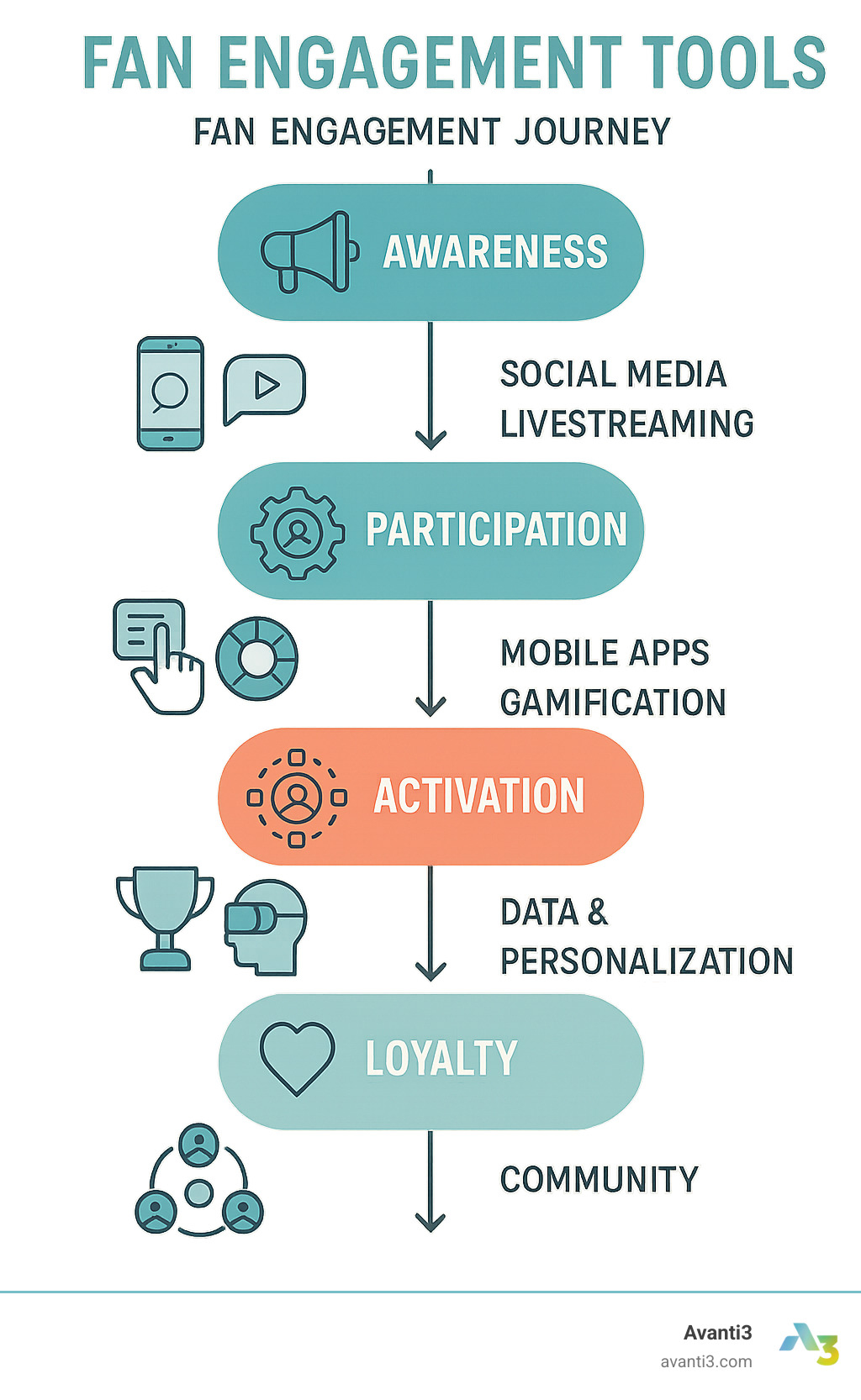
The journey from casual observer to passionate advocate isn’t accidentalit’s carefully crafted through strategic digital touchpoints that meet fans wherever they are. And as we’ll explore in the following sections, this evolution isn’t slowing downit’s accelerating toward even more immersive, personalized experiences that will redefine sports fandom for generations to come.
Why Fan Engagement Matters in 2024
The economics of fan loyalty have transformed the sports landscape in 2024. Think about this: about 60% of sports fans are now willing to open their wallets wider for meaningful experiences with their favorite teams. This isn’t just a minor trend—it’s a massive opportunity for organizations that can create compelling connections.
The living room has become the new stadium. With 69% of fans now preferring to watch sports outside traditional venues, digital experiences have become the primary way most supporters connect with their teams. This fundamental shift requires a complete rethinking of how sports organizations engage their audiences.
“Fan engagement is absolutely key for any sporting institution, rights holder, governing body or even the individual sportsperson, as engagement is where growth comes from,” explains Remy Brooks, Joint Managing Director of Future Platforms.
For sponsors, the math is simple—better engagement equals better returns. The 2023 FIFA Women’s World Cup perfectly illustrates this value proposition, generating ad sales revenue nearly 50% higher than the previous tournament, with an estimated $83 million flowing in. These aren’t just impressive numbers—they’re proof that engaged fans deliver real financial impact.
Today’s fans aren’t just watching—they’re participating as members of passionate communities who deeply identify with their teams. Fan engagement tools help nurture these modern tribes, creating digital spaces where fans connect not just with teams and athletes, but with each other.
Research from Capgemini confirms what many of us already sense—younger generations especially crave digital-first experiences that improve traditional viewership rather than replace it.
Defining True Fan Engagement
True fan engagement isn’t a one-way broadcast—it’s a conversation that builds genuine emotional connections and lifetime value.
“Fan engagement in sports is the practice of providing a comprehensive and enjoyable experience for fans throughout their journey with a sports organisation,” says Josh Atheron of Wests Tigers. “This includes information, entertainment, and two-way communication before, during, and after events to build loyalty and drive revenue.”
The most powerful engagement happens when fans transform from spectators into participants. They don’t want to just watch from the sidelines—they want to feel heard, valued, and connected to something bigger than themselves.
As one creator beautifully put it: “Staying connected with my fans is the most important thing for me as a content creator, and a priority in my everyday life. While I’m unable to respond to every comment, message, or email, I always take time out of my day to connect with my followers.”
The Ripple Effects for Teams, Fans & Brands
When implemented thoughtfully, fan engagement tools create positive ripples that touch every aspect of a sports organization:
Ticket sales get a noticeable lift when fans feel connected. Even during a team’s slump, engaged fans still show up—and they’re often willing to pay premium prices for improved experiences.
The merchandise boost is equally impressive. When fans feel emotionally invested, they’re eager to wear their team’s colors and display their affiliation proudly.
Ad revenue climbs significantly with engaged audiences. The Women’s World Cup 2023 wasn’t just a sporting triumph—it was a commercial one, with ad sales soaring nearly 50% compared to the previous tournament.
Database growth becomes exponential. The Wests Tigers added over 10,000 new fans to their database in just a few weeks using targeted engagement strategies. This isn’t just a number—it’s 10,000 new opportunities for personalized marketing and ongoing revenue.
Community building becomes self-sustaining as passionate fans attract others into their orbit, creating powerful network effects that deepen existing connections.
“A little recognition goes a long way, and being able to simply say ‘thank you’ to my ‘penguins’ allows them to feel like they’re a part of our journey,” shares one content creator, highlighting how even simple engagement tactics can transform casual viewers into dedicated fans.
The message is clear: in 2024, fan engagement isn’t optional—it’s essential. The organizations that understand this fundamental truth are the ones pulling ahead, building deeper connections and stronger financial foundations for the future.
Digital Change of Fan Experiences
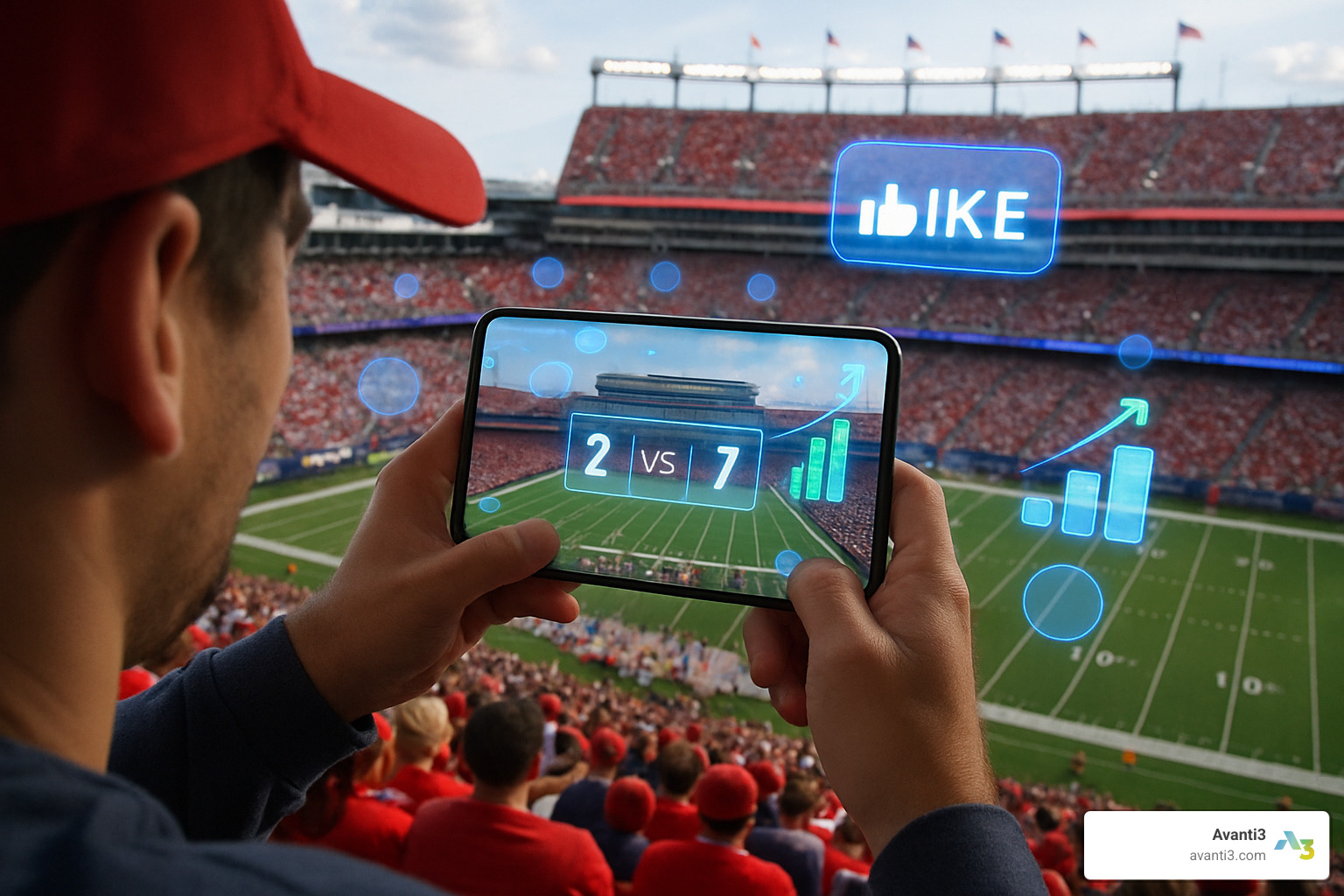
Remember when being a sports fan meant simply watching games on TV or sitting in the stands? Those days feel like ancient history now! The digital revolution has completely transformed how we connect with our favorite teams and athletes—and the pace of this change has only accelerated since the pandemic forced us all to find new ways to cheer from afar.
Today’s fan engagement tools have turned passive viewers into active participants in the sports experience. Mobile apps have become our personal command centers for everything from buying tickets to watching exclusive behind-the-scenes content. Live streaming has evolved far beyond basic broadcasts, now offering multiple camera angles, interactive features, and real-time stats that make us feel like we’re in the production booth.
AI has also changed the game, quite literally! Those personalized highlight reels that somehow always capture your favorite player’s best moments? That’s AI working behind the scenes to understand your preferences and deliver content that resonates with you personally.
At Avanti3’s Digital Fan Engagement division, we’ve seen how these technologies work best when they’re part of a cohesive strategy. Take the 2018 Open Tournament at Carnoustie as an example—golf fans received real-time highlights on their phones based on crowd reactions elsewhere on the course. This clever combination of AI, mobile tech, and social data created a more connected experience for everyone.
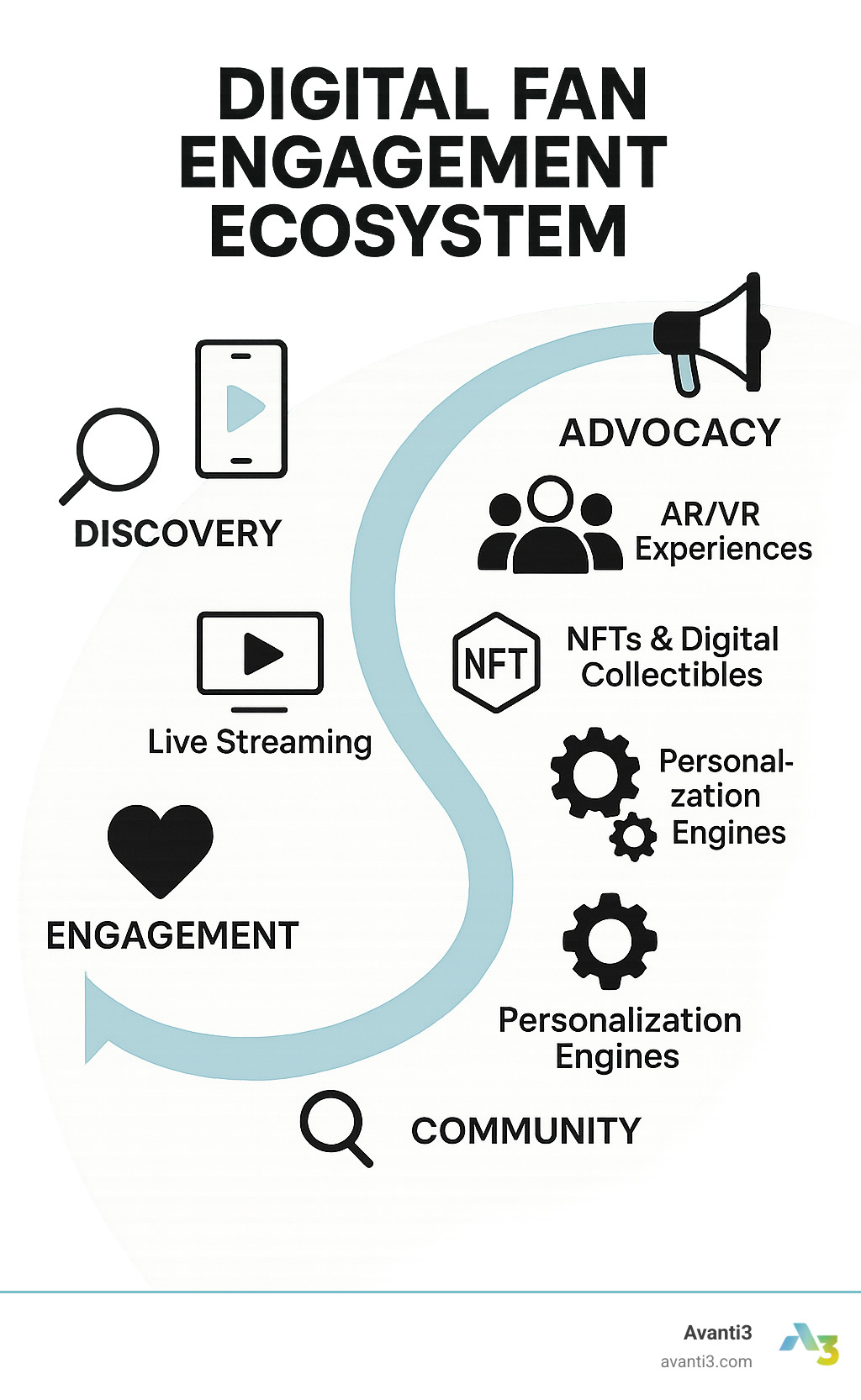
Data & Personalization Engines
The secret sauce behind modern fan engagement? It’s all about the data—specifically, high-quality first-party data that teams collect directly from their fans. This invaluable information helps organizations understand what makes individual supporters tick, allowing them to create experiences that feel tailor-made.
Think about how different your sports experience is from your friend’s. You might be a stats junkie who loves diving into player analytics, while they might care more about the social aspects of game day. Smart organizations now recognize these differences and segment their audiences accordingly. They know that die-hard season ticket holders need different content than casual viewers just getting into the sport. They understand that in-stadium experiences should be different from what they offer remote fans.
The really exciting part is when predictive analytics enters the picture. Imagine your favorite team knowing you’re likely to be interested in a special jersey release before you even realize it yourself! That’s the power of analyzing patterns across merchandise purchases, game attendance, and social media activity.
Of course, with great data comes great responsibility. The best organizations are completely transparent about how they collect and use fan information. They put fans in control of their own data while still delivering those personalized touches that make us feel special. It’s a delicate balance, but when done right, it creates trust alongside those personalized experiences.
Gamification: Turning Points into Passion
There’s something deeply satisfying about seeing your name climb up a leaderboard or earning that special badge that only 5% of fans have open uped. That’s why gamification has become such a powerful strategy for boosting engagement. By adding game-like elements to the fan experience, teams tap into our natural competitive instincts and desire for recognition.
Interactive quizzes that test your knowledge of team history, polls that let you predict the starting lineup, reward systems that recognize your loyalty—these elements create what psychologists call “dopamine loops” that keep us coming back for more. Each point earned or level achieved gives us a little hit of satisfaction that strengthens our bond with the team.
Fantasy sports represents perhaps the ultimate form of sports gamification, with more than 62 million people across the United States and Canada participating in fantasy leagues in 2022. These games transform passive viewers into active managers with a stake in games they might otherwise ignore completely.
As one content creator put it: “The weekly engagement list allows me to recognize those who are most active. Being able to simply say ‘thank you’ allows them to feel like they’re a part of our journey.” This sentiment captures the essence of successful fan engagement—making supporters feel valued and included in something bigger than themselves.
From AR experiences that overlay player stats when you point your phone at the field to blockchain-powered digital collectibles that fans truly own, the possibilities for digital fan engagement continue to expand. What remains constant is the human desire for connection, recognition, and shared experiences—now improved by technology rather than replaced by it.
Fan Engagement Tools Landscape
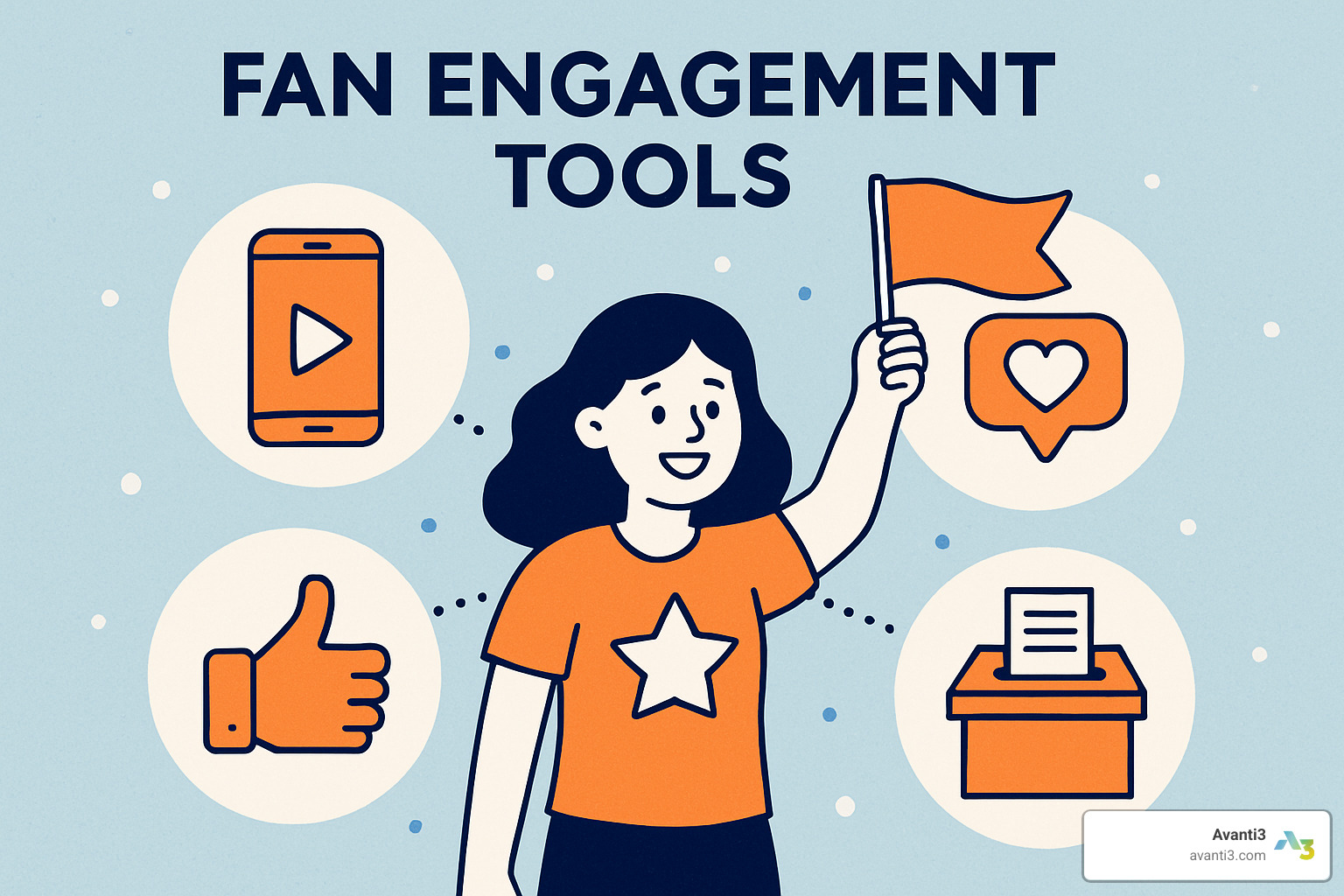
Remember when fan engagement meant simply cheering from the stands? Those days are long gone! Today’s fan engagement tools have transformed how teams connect with supporters, creating rich digital experiences that bring fans closer to the action than ever before.
The tools available to sports organizations have exploded in recent years. Whether you’re looking to showcase fan content during halftime, gather instant feedback through polls, or reward your most loyal supporters with exclusive perks, there’s now a solution designed specifically for your needs.
“The key objective was consumer engagement and that’s exactly what we got,” shares Neil O’Sullivan, a digital marketing expert who’s seen how these tools can transform relationships between teams and fans.
Modern platforms now offer everything from real-time voting that lets fans influence game decisions to social walls that turn individual posts into community celebrations. Digital loyalty wallets track engagement across platforms, while token-gating systems create VIP-like experiences for dedicated supporters. Behind it all, powerful analytics dashboards help teams understand what’s working and where to improve.
Fan Engagement Tools: Core Categories
When exploring fan engagement tools, it helps to understand the main categories and how each serves different aspects of the fan experience.
Social walls and UGC platforms have become stadium staples, turning individual social posts into collective celebrations. There’s something magical about seeing your tweet displayed on the jumbotron alongside thousands of other excited fans!
Interactive streaming platforms have transformed at-home viewing from passive to participatory. These solutions add polls, prediction games, and even virtual watch parties to broadcasts, making remote fans feel connected to the action and each other.
Community hubs and forums give fans a dedicated space to connect beyond game day. These digital clubhouses foster deeper relationships between supporters who might never meet in person but share a passionate bond over their team.
Digital collectibles have reimagined memorabilia for the digital age. From commemorating championship moments to open uping exclusive experiences, these blockchain-based items create new ways for fans to own a piece of team history.
Mobile app suites serve as command centers for the modern fan experience, bringing together tickets, content, merchandise, and community in one convenient place.
| Tool Category | Primary KPI Impact | Implementation Complexity | Cost Range |
|---|---|---|---|
| Social Walls | Engagement Rate, UGC Volume | Low | $ |
| Interactive Streaming | View Time, Interaction Rate | Medium | $$ |
| Community Platforms | Active Users, Retention | Medium | $$ |
| Digital Collectibles | Revenue, Premium Engagement | High | $$$ |
| Mobile Apps | User Base, Frequency, Retention | High | $$$ |
| AR/VR Experiences | Premium Engagement, Innovation | Very High | $$$$ |
Top Fan Engagement Tools for 2024
The most effective fan engagement tools in 2024 combine simplicity with power, allowing teams to create memorable experiences without requiring technical wizardry.
Mini-app suites have become incredibly popular, offering ready-to-deploy engagement tools. These modular solutions let teams mix and match features based on their specific needs, whether that’s trivia games during timeouts or prediction contests before the big match.
Livestream interactivity tools have transformed remote viewing from a solitary experience to a social one. Features like spoiler-free co-watching and influencer-driven chats make watching from home feel more like being at the stadium with friends.
AR ticket experiences are breathing new life into the humble ticket stub. These platforms transform standard tickets into interactive augmented reality experiences that begin the moment fans purchase their seats, creating new pre-game excitement and sponsorship opportunities.
Web3 loyalty programs are revolutionizing how teams reward their most dedicated supporters. Avanti3’s blockchain-based solutions connect engagement across platforms, rewarding fans with digital assets, exclusive access, and real-world benefits that recognize their ongoing support.
No-code campaign builders are putting powerful engagement tools in the hands of marketing teams without technical expertise. “We have already grown our database by 10,000+ new fans in a few weeks,” reports Josh Atherton from Wests Tigers, highlighting just how effective these accessible tools can be.
For teams looking to build comprehensive digital engagement strategies, platforms that integrate multiple tools into cohesive experiences offer the most value. You can learn more about these integrated approaches at Avanti3’s Digital Engagement Platforms page.
The best fan engagement tools don’t just collect likes or shares—they create meaningful connections that turn casual viewers into lifelong supporters. By choosing the right mix of tools for your audience, you can build a digital experience that feels personal, interactive, and authentically connected to your brand.
How to Choose & Implement Fan Engagement Tools

Navigating fan engagement tools can feel a bit like being a kid in a candy store – exciting, but potentially overwhelming. With so many shiny options available, how do you know which ones will truly satisfy your organization’s appetite for growth?
Let’s start with the basics. Before diving into demos and sales pitches, take a step back and think about what you’re really trying to accomplish. Are you looking to grow your fan database? Boost merchandise sales? Create unforgettable in-venue moments? Or perhaps build those year-round connections that keep fans thinking about you even in the off-season?
Understanding your audience is equally important. I once worked with a team that invested heavily in TikTok integration, only to find their core fans were primarily in their 40s and 50s and barely used the platform. Knowing where your fans hang out digitally saves both time and money.
Your technical environment matters too. The most amazing engagement platform in the world won’t help if it can’t talk to your ticketing system or CRM. Think of your tech stack like a family – everyone needs to communicate well for harmony to exist.
Budget considerations are always part of the equation. The good news? There are quality options at various price points. Be realistic about not just the initial investment, but the resources needed for ongoing management and content creation.
As one creator candidly shared, “I have not found a platform that focuses on community more than Facebook. The features really allow us to create a special corner of the Internet.” While this might work for individual creators, most sports organizations need more specialized tools designed specifically for fan engagement.
Scalability and compliance round out your pre-selection checklist. The solution that fits perfectly today might become restrictive as you grow, and data privacy requirements continue to evolve rapidly across different regions.
Must-Have Features in Fan Engagement Tools
When evaluating potential fan engagement tools, certain features stand out as non-negotiable in today’s digital landscape.
Multi-channel integration should be at the top of your list. Your fans don’t live in just one digital space, and neither should your engagement strategy. Look for tools that can pull content from various social networks and push experiences across multiple platforms.
Robust gamification capabilities turn passive viewers into active participants. Ashleigh Post, Digital Manager at MLSE, puts it perfectly: “We’re in an age where people just scroll through so frequently. To get someone to stop, look, take action, never mind buy a ticket, is huge these days.” Interactive elements like polls, quizzes, and leaderboards create those scroll-stopping moments.
Personalization has moved from nice-to-have to essential. Today’s fans expect experiences custom to their interests and behaviors. The tools you choose should help you deliver content that feels made just for them.
CRM and marketing platform connectivity ensures that the valuable data you collect actually goes somewhere useful. When your engagement tools talk seamlessly to your existing customer systems, you create a virtuous cycle of better understanding and serving your fans.
Comprehensive analytics help you measure what’s working and what isn’t. Without clear visibility into engagement metrics and user behavior, you’re essentially flying blind.
Finally, security and compliance features protect both your organization and your fans. Strong data protection and privacy controls aren’t just good practice – they’re increasingly required by law.
Implementation Roadmap: From Pilot to Scale
Bringing new fan engagement tools into your organization is a journey, not a flip of a switch. Success typically follows a clear pathway.
First, secure stakeholder buy-in across departments. I’ve seen brilliant engagement initiatives fail simply because the digital team didn’t bring operations or commercial colleagues along for the ride. Creating alignment early saves headaches later.
Next, carefully plan your data approach. Map out how information will flow between systems and what historical data needs to migrate. This unglamorous step often determines whether your new tools will shine or struggle.
Before going all-in, conduct sandbox testing with small pilot programs. These controlled experiments help identify issues early when they’re easier and less expensive to fix. As Paul Harris from Live Nation Entertainment notes, the best implementation partners “don’t put a guideline or specification on your own goals, they adapt to what your goals and needs are and they listen.”
Don’t forget to develop sponsor activation strategies. New engagement tools often create fresh opportunities for partners to connect with fans. These can become valuable additional revenue streams when thoughtfully designed.
When you’re ready to launch, consider a phased rollout rather than a big bang approach. Implementing features gradually allows you to gather feedback and make adjustments along the way. The fans who participate in early phases often become your biggest advocates.
Comprehensive staff and partner training ensures everyone can maximize the potential of your new tools. Even the most intuitive platforms benefit from proper onboarding.
Finally, commit to continuous monitoring and optimization. The digital landscape evolves rapidly, and what works today might need refinement tomorrow. The most successful organizations view their engagement tools as living systems that require ongoing attention and care.
By following this structured approach to selection and implementation, you’ll be well-positioned to choose fan engagement tools that truly transform your relationship with supporters and drive measurable business results.
Measuring Success & Maximizing Revenue
When you invest in fan engagement tools, you want to see real results that impact your bottom line. It’s not just about creating cool experiencesit’s about turning those moments into measurable growth for your organization.
Think of fan engagement like planting seeds that grow into various revenue streams. The most successful sports organizations track several key metrics to understand how well their engagement efforts are paying off:
Engagement rate tells you what percentage of your audience is actively participating with your content. This is your first clue that fans are paying attention rather than scrolling past. Customer Lifetime Value (CLV) takes a longer view, showing you the total revenue a fan brings in throughout their entire relationship with youfrom their first ticket purchase to their twentieth jersey.
Merchandise uplift is often one of the most visible wins. When fans feel emotionally connected to your team, they want to show it by wearing your colors and displaying your logo. As Josh from the Wests Tigers told me, “We saw a 23% increase in merchandise sales after implementing our new engagement platform.”
Sponsorship ROI has become increasingly important too. Brands are willing to pay premium prices to connect with highly engaged fan communities. And finally, ticket yield helps you understand how engagement affects not just the number of tickets sold, but also their pricing power and secondary market activity.
Want to dig deeper into turning engagement into sponsor dollars? Check out these strategies for digital sponsorship activation that can transform fan connections into revenue opportunities.
Fan Engagement Tools ROI Formula
The beauty of modern fan engagement tools is that they create multiple revenue streams simultaneously. It’s not just about selling more ticketsit’s about creating an ecosystem where fans spend more across every category.
Your advertising inventory becomes more valuable when you can demonstrate higher engagement rates and better targeting capabilities. Digital asset sales through NFTs and collectibles create entirely new revenue opportunities that didn’t exist a decade ago. Premium memberships become easier to sell when fans feel like insiders rather than just customers.
“We’ve seen our most engaged fans spend up to 4.2 times more on merchandise than casual fans,” shares Siobhan Chaplow, Chief Communications Officer at Bolton Wanderers FC. “The emotional connection drives purchasing behavior in ways traditional marketing simply can’t match.”
Even ticket sales benefit in multiple waysengaged fans attend more events, bring friends, and are willing to pay higher prices for special experiences. This ripple effect extends to sponsorships, where partners consistently pay premiums to reach highly engaged audiences.
Bolton Wanderers found particular success with fan feedback tools: “The ability to quickly gather fan feedback, analyze it, and re-engage with new survey options was invaluable in our kit design process,” Chaplow explained. The result? Their highest-selling kit launch in five years.
For teams looking to build comprehensive reward systems that drive both engagement and revenue, Avanti3’s Digital Reward System offers a powerful starting point.
Case Studies & Success Stories
Real-world success stories provide the most compelling evidence for the effectiveness of fan engagement tools. Let me share a few that demonstrate the potential when these tools are implemented well:
The 2023 Women’s World Cup shows what’s possible at a global scale. The tournament employed a sophisticated mix of omnichannel marketing, influencer partnerships, and AR filters to boost engagement across multiple platforms. The financial impact was undeniablead sales revenue jumped nearly 50% higher than the previous tournament, reaching an estimated $83 million.
On a more innovative front, a major sports organization created a virtual reality museum allowing fans to compare their athletic skills with professional players. This wasn’t just a cool tech demoit attracted entirely new audience segments and increased their digital engagement metrics by over 200% in just three months.
The Wests Tigers’ success with database growth shows how engagement translates to marketable contacts. Using a no00code fan engagement platform, they added over 10,000 new fans to their database in just a few weeks. Each of those fans represents ongoing opportunities for personalized marketing and revenue generation.
The fantasy sports boom provides another fascinating angle. More than 62 million people participated in fantasy sports leagues across the United States and Canada in 2022. This massive audience demonstrates how gamification creates communities and drives deeper engagement with sports properties.
James Askey, Head of CRM, Marketing & Insight at Cardiff City FC, notes that having comprehensive survey capabilities with rapid turn-around insights has been “a game-changer” for the club, enabling the team to act on fan feedback quickly and confidently.
These success stories aren’t outliersthey represent what’s possible when organizations make fan engagement a strategic priority rather than just a marketing tactic.
Frequently Asked Questions about Fan Engagement Tools
What role do fan engagement tools play before, during, and after events?
The beauty of fan engagement tools is how they create a continuous connection with fans throughout their entire journey. They’re like digital companions that evolve alongside the fan experience.
Before an event, these tools build anticipation and excitement. They count down to kickoff, deliver personalized previews based on your interests, and make ticket purchasing seamless. For the true sports enthusiasts, they power fantasy leagues and prediction contests that get the competitive juices flowing well before the actual competition begins.
“Every football club in the country should be getting you in to help with that fan engagement piece,” says Neil Hart, CEO of Bolton Wanderers FC. “Giving fans that voice is really important.”
During the event itself, the experience transforms completely. For in-venue fans, AR overlays bring stats to life and digital activations create memorable moments. Remote viewers enjoy alternative camera angles and instant replays that make them feel like they’re directing their own broadcast. Real-time polls and voting features turn passive watching into active participation, while social walls showcase the community’s shared excitement.
After the final whistle, fan engagement tools keep the conversation alive. They extend the experience through curated highlights, deeper analysis, and opportunities for fans to share their thoughts. This ongoing connection is particularly valuable during off-seasons, when maintaining fan interest traditionally becomes challenging. Smart organizations use this time to recognize loyal participants and gather insights for future events.
How can social media & user-generated content boost engagement?
There’s something magical about seeing your content featured on your favorite team’s official channels. That’s why social media and fan-created content have become the secret weapons in modern fan engagement strategies.
User-generated content brings authenticity that polished brand messaging simply can’t match. When fans share their gameday experiences, homemade signs, or reaction videos, they’re creating content that feels genuine and relatable. This authenticity resonates with other fans in ways that professional productions sometimes miss.
The reach benefits are substantial too. Research shows that 77% of sports fans rely on social media to stay updated on their favorite teams. When enthusiastic supporters share their experiences, they introduce your brand to entirely new networks of potential fans.
Social media creates natural community bonds. Whether it’s celebrating a last-minute victory or commiserating after a tough loss, these shared emotional experiences bring fans closer together. Smart organizations nurture these connections by creating dedicated hashtags, featuring fan content on official channels, and using social walls to showcase the community’s collective voice.
“We’re in an age where people just scroll through so frequently,” explains Ashleigh Post, Digital Manager at MLSE. “So to get someone to stop, look, take action, never mind buy a ticket, is huge these days.”
Which metrics reveal true fan loyalty?
While likes and shares provide quick snapshots of engagement, understanding true fan loyalty requires looking deeper. The most revealing metrics tell a more complete story about your relationship with fans.
Frequency matters tremendously. How often does someone engage with your content? Daily interaction indicates a much stronger connection than occasional visits. Depth of engagement is equally important – there’s a world of difference between passively viewing content and actively creating or sharing it.
The most loyal fans engage across multiple channels. They follow your social accounts, use your mobile app, attend events, and purchase merchandise. This omnichannel engagement demonstrates a comprehensive commitment to your brand.
Longevity might be the most underrated loyalty metric. Fans who stick with you through losing seasons and off-seasons show a deeper connection than fair-weather supporters. Their emotional investment transcends performance.
Fan engagement tools that track advocacy behaviors are particularly valuable. When someone defends your brand in comment sections or actively recommends you to friends, they’ve moved beyond being a customer to becoming a true ambassador.
Financial investment remains a concrete indicator of loyalty. Spending on tickets, premium experiences, and merchandise demonstrates a willingness to put money behind their emotional connection.
“65% of fans said they want some form of content or information at least monthly during the off-season,” notes one industry expert. Meeting these expectations helps build the kind of lasting relationships that define truly successful fan engagement.
At Avanti3, we believe the future of fan engagement lies in creating these deeper, more meaningful connections that span the entire fan journey – before, during, and long after the final whistle.
Conclusion
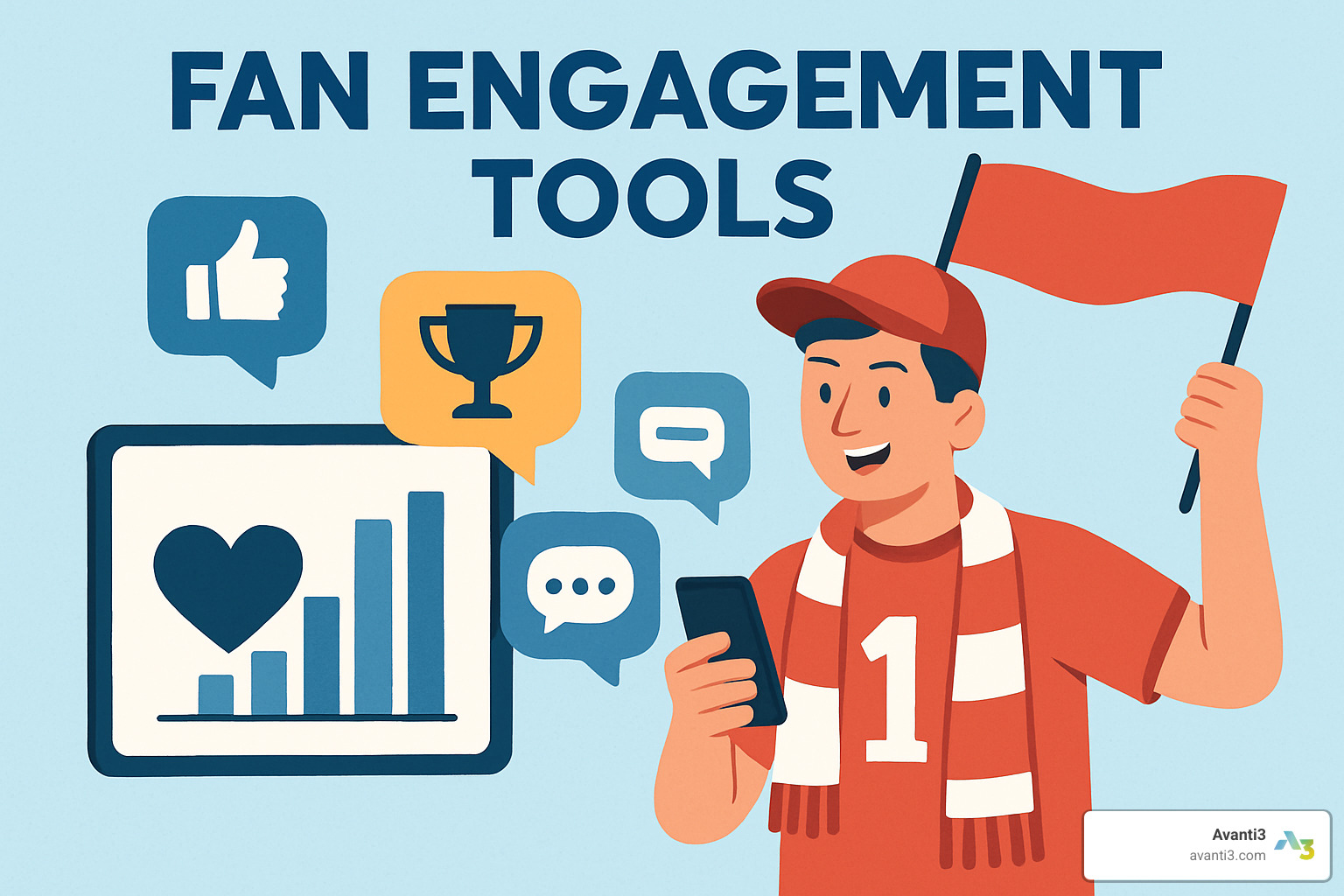
As we’ve explored throughout this guide, the landscape of fan engagement is changing at breakneck speed. What seemed like science fiction just a few years ago is now the everyday reality for forward-thinking sports organizations.
The stadium of tomorrow is already taking shape before our eyes. Imagine walking into your favorite venue where your smartphone instantly recognizes your location, offering personalized navigation to your seat while highlighting concession deals custom to your preferences. Your AR glasses overlay player stats as you watch the action, while interactive polls let you vote on the MVP alongside thousands of other fans doing the same.
Web3 technologies are opening doors to entirely new forms of connection. Fans aren’t just spectators anymore – they’re stakeholders with genuine ownership in the communities they love. Through blockchain-based systems, supporters can participate in team decisions, access exclusive experiences, and even share in the value they help create.
The beauty of these advancements isn’t just their technological brilliance, but how they’re fundamentally humanizing the relationship between sports entities and their fans. When done right, fan engagement tools don’t feel like technology at all – they feel like natural extensions of our passion.
At Avanti3, we’re passionate about making these connections feel effortless and authentic. We’re not just building tools; we’re creating bridges between organizations and the people who love them. Our integrated approach combines the power of NFTs, blockchain, augmented reality, and artificial intelligence to create experiences that fans genuinely treasure.
What excites me most about the future isn’t just the technology itself, but the possibilities it creates for genuine human connection. When a young fan receives personalized video congratulations from their hero after completing a challenge in a team app, that’s a memory that lasts a lifetime. When supporters separated by oceans can share the same virtual experience in real-time, that’s community-building that transcends physical limitations.
For organizations wondering where to begin this journey, the most successful engagement strategies always put fans at the center. The technology should serve the relationship, not the other way around. Start by deeply understanding what your supporters truly value, then build experiences that deliver those benefits in innovative ways.
The possibilities offered by tools like Augmented Reality NFTs aren’t just exciting – they’re transformative. They’re changing how we experience sports, how we connect with fellow fans, and how we express our loyalty to the teams and athletes we love.
The future of fan engagement isn’t just bright – it’s brilliantly interactive, deeply personal, and wonderfully human. And it’s happening right now, one digital high-five at a time.







